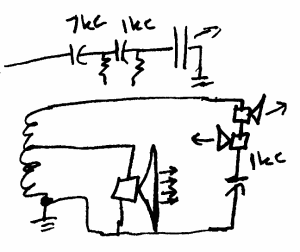grundig: 3028 USA; Grundig Majestic, nonpolarized capacitor
? grundig: 3028 USA; Grundig Majestic, nonpolarized capacitor

While servicing this radio, I found that after replacing C4 with a 10 ufd polypropylene capacitor, the radio sounds more sonicly correct. The original electrolytic capacitor measures at around 19 ufd on a capacitor checker with a very good ESR reading.
Seeing tone chokes in various circuits on this radio, are these radios more demanding of tighter tolerance components in their designs?
I understand the electrolytic capacitor rule of +100% / -50% being acceptable for capacitors, but considering that this capacitor is being used in a speaker circuit, most designers seem to prefer using non electrolytic capacitors for tonal consistency.
Attachments:
- C4 nonpolarized capacitor (17 KB)
To thank the Author because you find the post helpful or well done.
JPEG makes line-art fuzzy; I don't see "10uFd" on C4. A GIF might be easier to read.
> sounds more sonicly correct
This is not objective; there can't be an "answer" to a subjective observation.
However, I believe you.
19uFd where 10uFd was specified means more low-frequencies through SP2 and SP3, frequencies which should be (probably are) covered by big SP1. SP2 SP3 duplicate an octave of SP1, and may be straining to do so.
"very good ESR" is not a sufficient test for a speaker crossover cap. In an electrolytic, the actual ESR is different for different voltages; and in an old bipolar electro, different in each direction. The ESR may be low but its small variations produce distortion, both harmonic and intermodulation.
+90% tolerance and 1% THD is perfectly reasonable for a mass-produced radio (even a very deluxe one like this). With four speakers it surely sounded "bigger" than the lesser radios in the shop, and must have a nice cabinet. Could it have been better? Yes, but not for that price.
Bipolar electrolytics are still common in popular-price loudspeakers; nobody boasts about it, and when they do boast it is about poly-leather zircon-foil blessed caps (any film-cap is likely better here than commodity electros).
"Sonic correctness" was very low priority in mass-produced radios. COST was the main thing, high cost supported by nice cabinets. If the user tired of the sound in a few years, that's opportunity to sell another radio.
The radio did not get thrown-out, you the owner loves it enough to check for bad parts, a very different situation than it was born into. An "exact" restoration might use a fresh bipolar electro of slightly closer value (8-12uFd not 19uFd) in the old case. A hobbyist re-fresh might well use the film-cap that Grundig's designer should-have would-have used if profit was not an issue.
To thank the Author because you find the post helpful or well done.

To be more precise about , "sonicly correct", the radio does not have a thump anymore when listening to Jazz, Rock, Hip Hop, etc.
As for the capacitor that was replaced, since the radio at this time does not have any redeeming collector value, but is currently being enjoyed by someone who uses it primarily with his IPod and FM for Jazz, the 10 ufd polypropylene capacitor replaced the original electrolytic for enjoyment purposes, since it eliminated the thump.
The owner still possesses the original capacitor (which, by the way, has a positive side and negative side and DOES NOT indicate that it is nonpolar) and can return it to the radio at any time he chooses!
As for the comment that these radios were, "cheap" and "mass produced", is far from what the designers, manufacturers, and consumers viewed them at the time. High end German radios were not inexpensive when they originally were sold, and owners placed a lot of demand and expectations for these radios.
Since you appear to have somewhat of an aptitude on this subject, do of alot of inductors that are used in the tonal circuits place a greater demand for components to have tighter tolerances?
No audiophoolery is intended by this thread, but instead, a better understanding of the complex negative feedback system for this radio and the use of inductors.
To thank the Author because you find the post helpful or well done.
> do of alot of inductors that are used in the tonal circuits place a greater demand for components to have tighter tolerances?
There are a lot of inductors in series with the speakers. However these are, I believe, the small coils mounted inside above the tweeter. These have no effect at audio. We need much bigger coils to affect audio frequency. These are RF coils so that the speaker wires running all around the case do not act as antennas or resonators and spoil the radio receiver operation. We may ignore them.

The front 7"x10" speaker is the main sound. Such a speaker may be reasonably smooth from around 100Hz to over 5KHz on-axis, but will be beamy above 1KHz.
The left and right speaker have the same signal. They are fed from a different transformer tap, perhaps because the series pair is higher impedance than the single main speaker on the other tap. If I assume they are nominal 8 ohms, 16 ohms together, then the 10uFd capacitor reduces all signals below 1KHz; a "crossover" effect. Speaker impedance is not constant, and will rise to a higher impedance at cone resonance. If the crossover cap is too large (or shorted), this speaker bass resonance may "boom". With speakers like this, it might be a "thump".
The big 7x10 won't go much over 6KHz. The 5x7 speakers may go to 10KHz but only to the sides, and narrow above 2KHz. For FM reception where 15KHz is available, there is an octave missing from the top. They fill this with an electrostatic speaker. This is very high impedance and must be tapped from a hundreds-of-volts signal such as the EL84 plate. An RC filter removes tones below 7KHz which might harm the tweeter. Such a tweeter will usually work well past 10KHz and possibly past 20KHz.
Tolerances? I think the most critical tolerance is the speakers. Someone selected this combination of speakers and cabinet for a pleasing sound. The 10uFd cap may be important in how it acts with these particular side-speakers.
The values for R2D and R2B appear to be swapped on the SAMS schematic. R2D is probably a high value like Meg, R2B is more likely a lower value like K. The Tone and Treble designations may be swapped too, but this tone control is too complicated for casual analysis.
Attachments:- Grundig radio speaker array (6 KB)
To thank the Author because you find the post helpful or well done.

Thank you very much for the detailed explanation. Understanding how everything works around the speaker section, makes it a lot easier getting these radios to function as they were originally designed.
To thank the Author because you find the post helpful or well done.
Speaker Coils ?

Hello Friends !
look there post No 28
knoll'
To thank the Author because you find the post helpful or well done.
> look there post No 28
Thanks. A different model in the same series.
The small coils in the speaker are to break-up 100MHz effects on the internal FM antenna, and will be negligible at 50Hz-15KHz.
This model moves the side-speaker bass-cut capacitor to the primary, allowing a much smaller value, requring a second plate-to-speaker transformer, however this transformer may be quite small since no bass is applied to it. The cap and tranny could be designed together to give a 12db/octave bass-cut; however the "natural" transition from front-speaker to front+side speakers is not so abrupt and I suspect the transition is more lile 6dB/oct in the 500Hz-1KHz area. True, the 25nFd film-cap and transformer may be tighter tolerance than a 10uFd electrolytic, but also more expense and space.
Some wise men had fun trying various variations on this high-end domestic radio.
To thank the Author because you find the post helpful or well done.
de emphasis circuit

Thank you for the detailed explanation regarding the speaker section for this radio.
In reference to a recent thead on pre emphasis/de emphasis, I did make a calculation for the extra 25 uS for the de emphasis circuit (which is 600 pF), for the North American standard of 75uS. I placed the radio on the bassiest music (Hip Hop music) with the bass levels all the way down, and started from 600 pF and slowly gauged down to 430 pF. Any lower capacitence, brought back bass distortion "thump" on FM.
To thank the Author because you find the post helpful or well done.